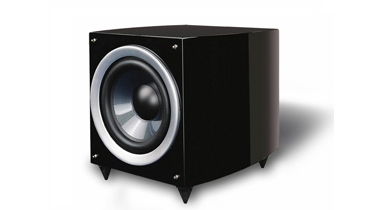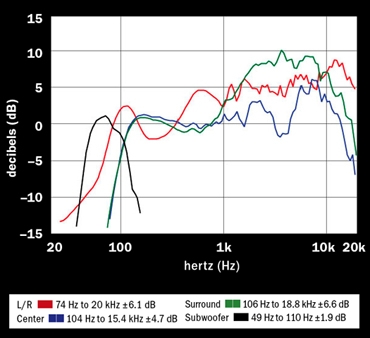Pure Acoustics Dream Tower home theater speaker system Page 3

TEST BENCH

Sensitivity (SPL at 1 meter with 2.8 volts of pink-noise input) front left/right: 92 dB center: 87 dB surround: 89 dB
Impedance (minimum/nominal) front left/right: 3.6/9 ohms center: 4.3/7 ohms surround: 4.9/8 ohms
Bass limits (lowest frequency and maximum SPL with limit of 10% distortion at 2 meters in a large room) front left/right: 80 Hz at 79 dB center: 125 Hz at 86 dB surround: 125 Hz at 82 dB subwoofer: 32 Hz at 98 dB SPL 102 dB average SPL from32 to 62 Hz 105 dB maximum SPL at 50 Hz Bandwidth uniformity: 96%
All of the curves in the frequency-response graph are weighted to reflect how sound arrives at a listener's ears with normal speaker placement. The curve for the left/right front channels reflects response of the Dream Tower 100 with the speaker standing on the floor averaged over a ±30º window. The center-channel curve reflects response of the Dream Tower 101 averaged over ±45º, with double weight directly on-axis of the primary listener. The surround-channel curve shows the response of the Dream Tower 102 averaged over ±60º.
Because the Model 100 will always be used on a floor, all measurements were taken with the speaker on a carpeted floor. Both the center- and surround-channel speakers were measured on a 6-foot stand, which gives anechoic results to approximately 200 Hz. All measurements, subwoofer excepted, are taken at a full 2 meters, a distance that emulates a typical listening distance, allows larger speakers to fully integrate acoustically, and, unlike near-field measurements, fully includes front- panel reflections and cabinet diffraction.
The Dream Tower 100 has a relatively mild floor bounce at 200 Hz, followed by a rising response of approximately 2 dB per octave above 400 Hz. The Dream Tower 101 center speaker has a 2. 5-kHz notch directly on-axis that falls in center frequency with increasing width and severity as you move further off-axis. The 102 surround speaker's tweeter measured 7 dB louder than its woofer above 1.5 kHz. All speakers in the system have anemic low-frequency dynamic capability, along with rather dramatically raised response at higher frequencies.
The Noble 10 subwoofer's bass limits were measured with it set to maximum bandwidth (Crossover Bypass and Flat trim) and placed in the optimal corner of a 7,500-cubic-foot room. In a smaller room, users can expect 2 to 3 Hz deeper extension and up to 3 dB higher sound-pressure level. Although the crossover dial is marked from 40 to 180 Hz, the true acoustical operating range only spans from 60 to 110 Hz. There is also a curious level/crossover interaction where the crossover at mid-rotation actually increases volume by 3 dB. (At the 40-Hz position, level was decreased by 13 dB.) The subwoofer's dynamic capability peaks fairly dramatically at 50 Hz, falling off at roughly 9 to 12 dB per octave both above and below that point.
- Tom Nousaine













































